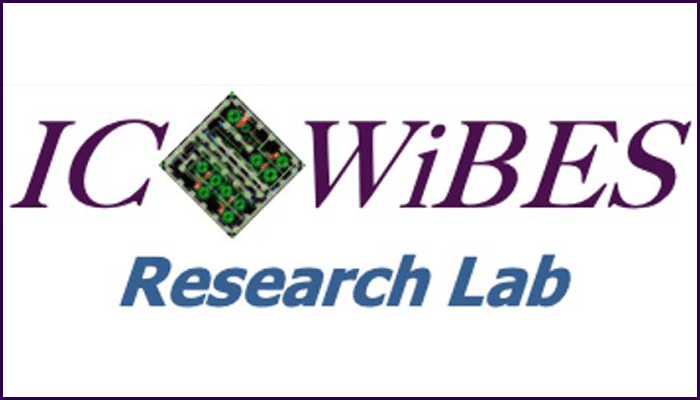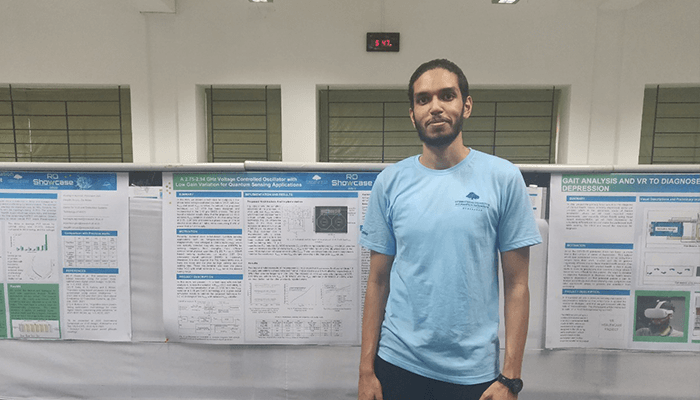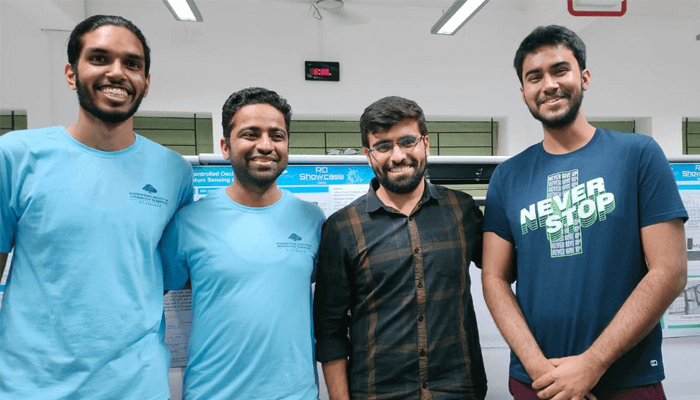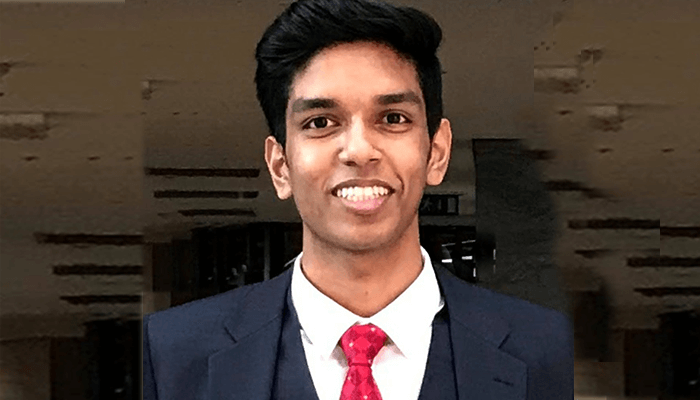Adithya Sunil Edakkadan, a 4th year B. Tech student from IIITH’s Center for VLSI and Embedded Systems Technology was recently awarded the Chanakya fellowship for his ongoing research in quantum sensing circuits. What fires the brain of the back-bencher who suddenly discovered his mojo? We check.
It was on Prof. Abhishek Srivastava’s advice that Adithya Sunil applied for the prestigious Chanakya fellowship in January 2022. “Having heard about it on the academic grapevine, he felt that it would give good recognition to the work we are doing in the quantum semi-conductor space”, says the young researcher.
The fellowship was awarded on the basis on Adithya’s proposals on ‘Design and Measurement of Microwave Signal Generator for Diamond Color Defect Based Quantum Sensing Applications’ that was presented in the 1st week of June at ISCAS 2022 and his previous publication ‘Design of 2.87 GHz Frequency Synthesizer with Programmable Sweep for Diamond Color Defect based CMOS Quantum Sensing Applications’ that was accepted in IEEE International Symposium on Circuits and Systems (ISCAS) 2022. A paper on ‘2.75-2.94 GHz Voltage Controlled Oscillator with Low Gain Variation for Quantum Sensing Applications’ was presented at the 35th International Conference on VLSI Design in 2022.
Doubting Thomas hits his stride in 3rd year
When the class topper from Dubai was suddenly thrown in with peers of equal cranial power, it was a challenge. From top student to back bencher in his first two years at IIITH was brutal. “I wasn’t quite motivated to work”, muses Adithya who joined Prof. Abhishek’s research group ‘IC~WiBES’ (Integrated Circuits inspired by Wireless and Biomedical Electronic Systems) at CVEST. Prof. Abhishek gave the youngster an interesting problem – a frequency synthesizer circuit with very small sweep steps, that piqued his curiosity. “I didn’t have previous knowledge of quantum sensing and I found the field quite interesting and dived deeper into it.” While working on the problem in collaboration with Prof. Kasturi Saha and Prof. Maryam Shojaei Bhagini of Electrical Engineering Department, IIT Bombay, they realized that quantum sensing is an area where the physical specifications of their design would come in handy and they started looking more into quantum sensing circuits.

“At ‘IC~WiBES’ research lab, we are currently at the circuit design stage and should be getting our prototype ready by August,” reports Adithya. “I designed my Chip on the SkyWater 130nm PDK and submitted for a tapeout to the Efabless Open MPW shuttle Program, a Google funded program that basically funds the manufacturing of chips that you design using their technology.”

How to apply for the Grant
The DST-funded Chanakya fellowships are instituted by the I-Hub Quantum Technology Foundation (QTF) under the aegis of the Indian Institute of Science Education and Research at Pune. The six month long undergraduate/post-graduate fellowship will support research in quantum computing systems and to build applications in sensors, navigation, geo-mapping, clocks, communications and material design.
The application process requires details of the applicant, mentor-advisor and host institute along with the research problem being explored with deliverables and deadlines. Adithya advises aspirants to start their research in quantum technology in the third year of the UG program or from the start of the program, for Masters students. “If you have already published or are in the process of writing a paper, it shows your proof of intention”, he observes.
Why would a student choose ECE?
Adithya chose IIITH as it stood out as one of the best in India and from his point of view, its admission schemes were very friendly to international applicants. “I actually joined with the idea of getting a job in a programming industry”, he confesses. Soon it would dawn on him that he was more oriented towards research in hard-core electronics and the circuit side rather than software engineering.
The Dean’s Merit List award recipient credits his advisor for what he is today. “CVEST made a sea change in me” says he. “I am here because of my advisor Prof. Abhishek who was very supportive, committed and quick with follow ups.”
“CVEST is a great place to be”, he admits. “It may not be as recognised as CVIT but we are contributing a lot in mmWave/RF/Analog IC design, IoT, photonics and embedded systems. We have regular publications in leading journals and top end conferences like ISCAS, including two this year and that’s a good achievement”.
ECE at IIIT is especially well-tailored for students going into design and offers a clear understanding of what is needed to make it in the industry. “Our courses are more oriented towards getting us into research as we are taught to look deeper into subjects. In the first semester at IIITH, everyone is still in the competitive-exam mode. In the 2nd year, they tend to calm down and are open to helping each other out, which is a great system”, he comments. “I think the collaborative environment is the best thing about IIITH”.
Walks, talks and Elektoberfest
There is a lot to do around the campus, observes Adithya. “We have just enough cultural events to maintain a good social life here”.
As Coordinator for the Institute’s Electronics and Robotics Club, his team has been regularly organising competitions, workshops and Talks. “One of the things we introduced during the Hacktoberfest was an electronics competition called Elektoberfest” , says Adithya who is an Open source contributor to various projects like Homebrew, Webi and BaseJump STL. He is part of the IC WiBES Research Lab (Integrated Circuits inspired by Wireless and Biomedical Electronic Systems) at CVEST. He has had two stints as a Student Developer @ FOSSI, an open source organization that works on developing open source toolchains for FPGA and ASIC design to make VLSI design more accessible to the common public, under the Google Summer of Code program.
Recently, Adithya traded in his basketball spikes for the ukulele, after a knee injury. The heavy metal-head enjoys hanging out with friends on campus, binge-watching shows and early morning walks.
“My ambition drives me”, he says. Whenever I hit a speed bump, I head to Prof. Abhishek’s office and we discuss and figure it out.” He is currently working on a couple of projects in FMCW radars systems and respiratory audio processing. He will be presenting a paper on Deep Learning based Object Detection and Classification using FMCW Radars for Automotive Applications for a sensors journal. He, along with his colleagues, is also competing in the BioCAS 2022 Grand Challenge with their project Mel Spectrogram and MFCC based Classification of Respiratory Sounds in Children.

Get the Jump on Chip design
“It’s a great time to be involved in the VLSI industry”, says Adithya who is seriously considering converting to a dual degree program to further his research interests in circuit design and embedded systems. He explains that NV Magnetometry for Diamond Color Defect Based Quantum Sensing Applications is an upcoming area. Its application will be mostly seen in research laboratories for portable sensing of accurate magnetic field measurement, MRI machines and certain aspects of life sciences and material sciences.
Even though, ECE is more demanding, the rewards are way higher because the VLSI industry is growing pretty rapidly right now. Recently, after the Prime Minister sanctioned massive funding to institutions and industries working in chip development, VLSI and semi-conductor manufacturing, Adithya forecasts that there is going to be a large demand for chip designers.
He would like to acknowledge the contributions of IIIT Hyderabad and CVEST in facilitating his research. He also extends his gratitude to Prof. Kasturi Saha and Prof. Maryam Shojaei Bhagini of Electrical Engineering Department, IIT Bombay, for their valuable contributions as collaborators to the NV magnetometry work. He also thanks the Department of Science and Technology, IISER Pune, I-Hub Quantum Technology Foundation (QTF), Google, SkyWater and Efabless for their contributions to supporting research in the field of VLSI design.



Next post